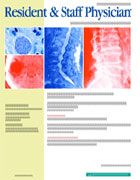Publication
Article
Resident & Staff Physician®
Article on Malaria Missed Important Points
To the Editor:
The article "Management of Lateonset Malaria" by Drs Schmitt and Cruz (June 2005) requires some comments and clarifications.
Plasmodium falciparum
1. The signs and symptoms of malaria are protean. Malaria can present with nearly any manifestation (other than rashes) and is almost always misdiagnosed in the United States by the physician, although the laboratories usually make the correct diagnosis.1 In contrast to what is stated in the article, the classic stages are not typical; in fact they are least likely with the most dangerous form, caused by . Suspected cases warrant consultation with tropical medicine specialists, not just infectious disease specialists, as few of the latter have seen or are experienced with this disease.
2. Crucial to proper diagnosis is the blood smear. To correctly perform smears, 3 separate samples must be done over a 12 to 36 hour period, ideally with fever spikes, and a proper smear examination can take 1 full hour, and US laboratories rarely perform it properly. Few technicians are experienced enough to perform this smear correctly, and so a "negative" blood smear report can rarely be trusted. This means that clinicians who rely upon the laboratory results may incorrectly rule out malaria.
3. A vitally important point that was not emphasized enough is the need to take a proper travel history. The relative risk varies enormously between the regions listed in the article, with sub-Saharan Africa and Oceania being at the highest risk for falciparum malaria. Although vivax malaria is more prevalent, the overwhelming majority of malaria deaths result from falciparum malaria. It is critical to ask about pretravel education and chemoprophylaxis. To say that, "Occasionally, travelers fail to obtain prophylactic therapy before traveling," is wrong—most fail to take chemoprophylaxis correctly and clinicians frequently give an inappropriate medication to the traveler.
4. Prevention is not based upon the liberal use of insecticides but of insect repellents. Insecticides, such as permethrin, are supplementary. There is no way to prevent malaria infection; we aim to prevent disease. Within 30 minutes of the mosquito bite, all the protozoa are taken up in the liver. Preventive and therapeutic medication aims to kill the parasites as they leave the liver or as they mature within the liver.
5. Most cases of falciparum malaria will present within a few months, not years, of returning home after visiting endemic areas. A prolonged and delayed presentation of malaria usually occurs with the nonfatal forms.
6. Because of the inadequate ability to properly diagnose malaria, when a smear is positive, it must be reviewed by an expert to rule out falciparum malaria. Patients infected with falciparum malaria require intensive care unit admission, since they can die if not treated properly.
7. The mosquito shown is not an anopheline but a culicine. Anopheline mosquitoes do not feed horizontally; when they bite, they are at a 30° to 45° angle to the skin.
For more information see the American Society of Tropical Medicine and Hygiene Web site at www.astmh.org.
Alan M. Spira, MD, DTM&H, FRST
The Travel Medicine Center, Beverly Hills, Calif
Ann Emerg Med
1. Kyriacou DN, Spira AM, Talan DA, et al. Emergency department presentation and misdiagnosis of imported falciparum malaria. . 1996;27:696-699.
The Authors Reply:
Dr Spira's comments are a welcome addition to the little information available in the primary care setting. The primary objective of the article was to increase the awareness among primary care physicians that malaria should be included in the differential diagnosis of a febrile illness. The missing information and inaccuracies reflect the paucity of knowledge about malaria in primary care. However, the picture of the mosquito and its attribution were taken directly from the Centers for Disease Control and Prevention Web site. We hope that our article has stimulated an interest in this deadly disease.
Robert L. Schmitt, MD
Stacie Cruz, MD
Family Medicine Residency Program, Fontana, Calif
